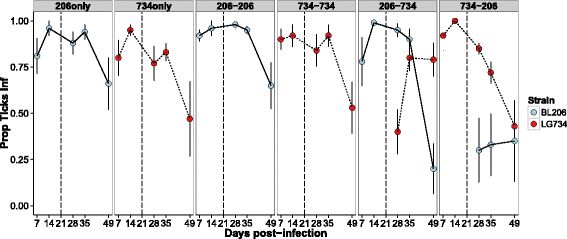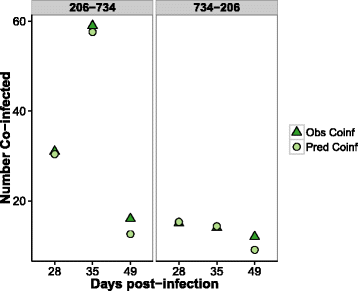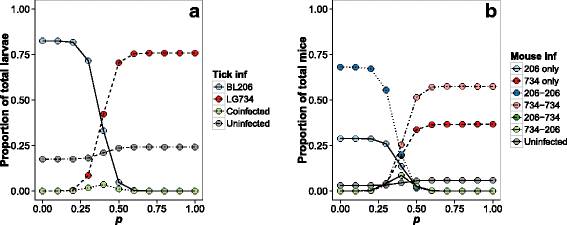Closely-related Borrelia burgdorferi (sensu stricto) strains exhibit similar fitness in single infections and asymmetric competition in multiple infections
- PMID: 28166814
- PMCID: PMC5292797
- DOI: 10.1186/s13071-016-1964-9
Closely-related Borrelia burgdorferi (sensu stricto) strains exhibit similar fitness in single infections and asymmetric competition in multiple infections
Abstract
Background: Wild hosts are commonly co-infected with complex, genetically diverse, pathogen communities. Competition is expected between genetically or ecologically similar pathogen strains which may influence patterns of coexistence. However, there is little data on how specific strains of these diverse pathogen species interact within the host and how this impacts pathogen persistence in nature. Ticks are the most common disease vector in temperate regions with Borrelia burgdorferi, the causative agent of Lyme disease, being the most common vector-borne pathogen in North America. Borrelia burgdorferi is a pathogen of high public health concern and there is significant variation in infection phenotype between strains, which influences predictions of pathogen dynamics and spread.
Methods: In a laboratory experiment, we investigated whether two closely-related strains of B. burgdorferi (sensu stricto) showed similar transmission phenotypes, how the transmission of these strains changed when a host was infected with one strain, re-infected with the same strain, or co-infected with two strains. Ixodes scapularis, the black-legged tick, nymphs were used to sequentially infect laboratory-bred Peromyscus leucopus, white-footed mice, with one strain only, homologous infection with the same stain, or heterologous infection with both strains. We used the results of this laboratory experiment to simulate long-term persistence and maintenance of each strain in a simple simulation model.
Results: Strain LG734 was more competitive than BL206, showing no difference in transmission between the heterologous infection groups and single-infection controls, while strain BL206 transmission was significantly reduced when strain LG734 infected first. The results of the model show that this asymmetry in competition could lead to extinction of strain BL206 unless there was a tick-to-host transmission advantage to this less competitive strain.
Conclusions: This asymmetric competitive interaction suggests that strain identity and the biotic context of co-infection is important to predict strain dynamics and persistence.
Keywords: Co-infection; Ixodes scapularis; Peromyscus leucopus; Strain diversity.
Figures





Similar articles
-
Interaction and transmission of two Borrelia burgdorferi sensu stricto strains in a tick-rodent maintenance system.Appl Environ Microbiol. 2004 Nov;70(11):6783-8. doi: 10.1128/AEM.70.11.6783-6788.2004. Appl Environ Microbiol. 2004. PMID: 15528545 Free PMC article.
-
Comparative reservoir competence of Peromyscus leucopus, C57BL/6J, and C3H/HeN for Borrelia burgdorferi B31.Appl Environ Microbiol. 2024 Jul 24;90(7):e0082224. doi: 10.1128/aem.00822-24. Epub 2024 Jun 20. Appl Environ Microbiol. 2024. PMID: 38899883 Free PMC article.
-
Vector seasonality, host infection dynamics and fitness of pathogens transmitted by the tick Ixodes scapularis.Parasitology. 2007 Feb;134(Pt 2):209-27. doi: 10.1017/S0031182006001417. Epub 2006 Oct 11. Parasitology. 2007. PMID: 17032476
-
Ecology of Borrelia burgdorferi sensu lato in Europe: transmission dynamics in multi-host systems, influence of molecular processes and effects of climate change.FEMS Microbiol Rev. 2012 Jul;36(4):837-61. doi: 10.1111/j.1574-6976.2011.00312.x. Epub 2011 Dec 28. FEMS Microbiol Rev. 2012. PMID: 22091928 Review.
-
Borrelia burgdorferi and tick proteins supporting pathogen persistence in the vector.Future Microbiol. 2013 Jan;8(1):41-56. doi: 10.2217/fmb.12.121. Future Microbiol. 2013. PMID: 23252492 Free PMC article. Review.
Cited by
-
Adaptive immunity in Mus musculus influences the acquisition and abundance of Borrelia burgdorferi in Ixodes scapularis ticks.Appl Environ Microbiol. 2024 Dec 18;90(12):e0129924. doi: 10.1128/aem.01299-24. Epub 2024 Nov 6. Appl Environ Microbiol. 2024. PMID: 39503497 Free PMC article.
-
Competition between strains of Borrelia afzelii inside the rodent host and the tick vector.Proc Biol Sci. 2018 Oct 31;285(1890):20181804. doi: 10.1098/rspb.2018.1804. Proc Biol Sci. 2018. PMID: 30381382 Free PMC article.
-
Outer surface protein polymorphisms linked to host-spirochete association in Lyme borreliae.Mol Microbiol. 2019 Apr;111(4):868-882. doi: 10.1111/mmi.14209. Epub 2019 Feb 27. Mol Microbiol. 2019. PMID: 30666741 Free PMC article. Review.
-
Meta-analysis of tick-borne and other pathogens: Co-infection or co-detection? That is the question.Curr Res Parasitol Vector Borne Dis. 2024 Oct 5;6:100219. doi: 10.1016/j.crpvbd.2024.100219. eCollection 2024. Curr Res Parasitol Vector Borne Dis. 2024. PMID: 39483631 Free PMC article. Review.
-
Within-host priority effects and epidemic timing determine outbreak severity in co-infected populations.Proc Biol Sci. 2020 Mar 11;287(1922):20200046. doi: 10.1098/rspb.2020.0046. Epub 2020 Mar 4. Proc Biol Sci. 2020. PMID: 32126961 Free PMC article.
References
Publication types
MeSH terms
Grants and funding
LinkOut - more resources
Full Text Sources
Other Literature Sources

